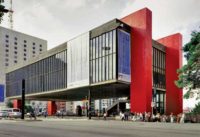Christian de Portzamparc's massive, much-maligned Cidade das Artes is a grandiose emblem of Rio's ambitions.
| Photo © Hufton+Crow |
| Sail-like sheets of structural concrete enclose theaters and support the elevated spaces. |
On first impression, Rio de Janeiro's Cidade das Artes seems an act of architectural hubris and urban lunacy. Opened to the public last year after almost a decade of interrupted construction and cost overruns, it has been mired in criticism as a symbol of economic stratification in a city where an estimated 20 percent of the population resides in favelas.
The Cidade das Artes is the love child of Christian de Portzamparc and Cesar Maia, an ambitious former mayor once determined to put Rio on the global culture map. Maia's vision was for a Cidade da Musica—not Artes—modeled on Portzamparc's Cité de la Musique in Paris. And the architect was no stranger to the city: Elisabeth, his wife of more than 30 years, is a Carioca (a Rio native). When the then mayor summoned Portzamparc urgently to Rio in 2002, Maia announced that they would visit the site by helicopter, without disclosing the location. The helicopter headed west past Zona Sul's well-heeled neighborhoods and finally hovered over a vacant site at a key intersection surrounded by highways in Barra di Tijuca, almost 20 miles west of the city center.
Known colloquially as Barra (sandbar), this 10-mile stretch of beachfront masterplanned by Lúcio Costa in the 1960s has undergone explosive development. Gated condominium complexes and shopping malls cater to Rio's burgeoning upper middle classes. Maia envisioned the Cidade da Musica as a gateway to Barra, a cultural landmark amid urban sprawl in an area devoid of public facilities.
Portzamparc assembled a local team that included two structural engineers who had worked with Oscar Niemeyer and landscape architect Fernando Chacel, a former collaborator of Brazilian landscape architect Roberto Burle-Marx. He was determined to pay homage to Brazilian Modernism, in which, he says, “Structure makes the architecture.”
The nearly 1 million-square-foot complex is set on a concrete plinth 32 feet above the ground on which two auditoria are raised, following what Portzamparc refers to as an “open block principle,” with free volumes contained by a fixed form. The Cidade is a rhomboid structure framed between two horizontal concrete planes. They enclose the two concert halls, a dance studio, movie theaters, rehearsal rooms, restaurants, and a series of ancillary facilities. For Portzamparc, the open block mimics the street by creating semi-public space linking the different programs.
In place of piloti, curving triangular “veils” of post-tensioned structural concrete which enclose the performance halls penetrate the elevated floor slab and extend to the ground to support the building. Lifting the building off the ground creates views of the sea and the surrounding mountains, and distance from the swirling traffic below.
The project brief called for a philharmonic concert hall that could also be adapted for opera, as well as a second, smaller auditorium for chamber music. These technically complex spaces were delivered to a very high standard with the collaboration of acoustician Albert Yaying Xu of Paris-based Xu-Acoustique. But Maia's successor, Eduardo Pais, halted construction on the Cidade da Musica in 2009, wanting to disassociate himself from his predecessor's grandiose scheme. Only when Rio won the Olympics, and a nearby site in Barra was earmarked for the Olympic Park, did Pais acknowledge that the neighborhood's white elephant must be completed. To broaden its audience and strengthen its business plan, the Cidade da Musica was rebranded as the Cidade das Artes, and the Grande Sala designed for symphony and opera is currently programmed for theater, dance, and all forms of music. Portzamparc is delighted that the building is at last operational, but notes, “We delivered a Ferrari concert hall which the client is using as a conventional car.”
The building is a thoughtful response to the original brief, though it is overscaled and overly complex. Portzamparc has designed a forbidding performing-arts complex of Piranesian proportions in an area of Rio where shopping malls are the closest thing to public space. Despite its high-tech concert halls, this is not a forward-looking building. It fails to address critical 21st-century realities such as sustainability or socially inclusive programming. Conceived as permeable by the surrounding city, the entire site is fenced for security.
Yet the very generosity of the building's elevated veranda, with its stunning views of this rapidly growing area of Rio, may be its saving grace. It has already become a popular setting for television advertisements and commercial photography: Brazil's November Vogue featured several fashion spreads with the Cidade das Artes as a backdrop. If supported by wide-ranging programming that draws on Rio's wealth of cultural diversity, the building could evolve into a vibrant venue and attract many different audiences. One can easily envision a samba school rehearsing in the building's plaza-like open spaces. With the right programming, Cidade could serve the city that its architecture keeps at a distance.
The Architects' Journal








Post a comment to this article
Report Abusive Comment